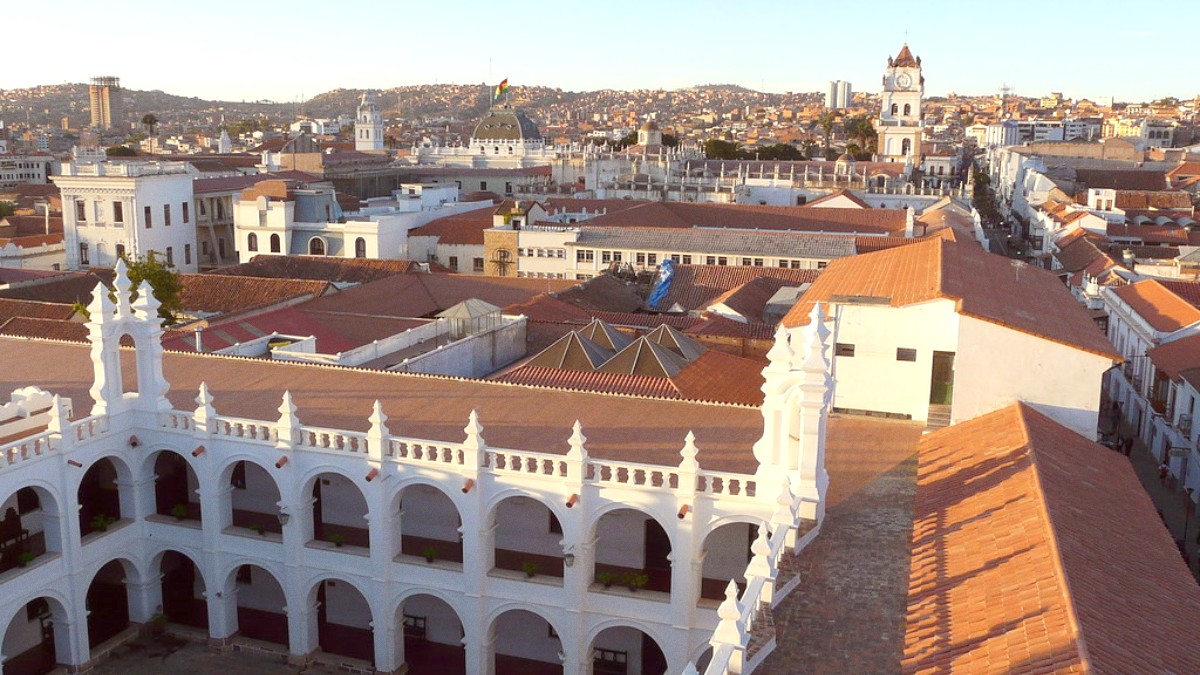
The Southwest, Bolivia
Bolivia is the origin of the potato, with hundreds of varieties. Corn (maiz) is in many forms, including hominy corn (mote). Quinoa, an ancient grain, is a dietary staple. Beef, chicken, and pork are common, often stewed, grilled, or fried. Ají amarillo (yellow chili pepper) and ají colorado (red chili pepper) give characteristic flavor to many dishes; Sucre's cuisine favors milder varieties.
Fresh, soft cheeses (quesillo) are common. Various local breads are at markets and bakeries. Local herbs like wakataya and common spices like cumin, garlic, and onions make the flavor base of many savory dishes. Flavors lean towards savory, sometimes with subtle sweetness or mild spice, and often feature rich, stewed textures.
Breakfast: Often small, coffee or tea, bread, sometimes cheese or eggs. Lunch (Almuerzo): The largest and most important meal. Typically includes soup (sopa), a main course (plato de fondo), and a small dessert or fruit. Dinner (Cena): Lighter than lunch, often soup, a light main dish, or sandwiches.
Forks, knives, and spoons are generally available, even at more casual eateries.
When drinking alcohol in a group, making a toast, usually with "¡Salud!" (Cheers!), is common.
A specialty of Sucre and the Chuquisaca region. It is typically with mote (hominy corn), potatoes, and chuño (freeze-dried potatoes).
Find Mondongo in traditional Bolivian restaurants.
Spicy pork sausages, a popular street food and restaurant item. Typically with bread and a small, fresh salad. These are a flavorful snack or light meal.
Look for street vendors and local restaurants.
A Bolivian staple, especially for breakfast or a mid-morning snack. Savory baked empanadas with a juicy, somewhat sweet and often spicy stew of meat, potatoes, peas, and sometimes a hard-boiled egg or olive. The soupy filling needs careful eating.
Find them at dedicated salteñerías open in the mornings.
Fresh, soft cheese, often served simply with fresh bread or fruit.
Small, delicious cheesy bread rolls made from yucca flour, naturally gluten-free. They are light, fluffy, and a popular snack.
Sucre has a few upscale restaurants. These have refined Bolivian cuisine, sometimes with a modern twist, or international dishes. Many are in luxury hotels or the historic center, for an elegant dining experience.
Numerous options are in the city center. They cater to locals and tourists, with a mix of traditional Bolivian dishes and international fare (Italian, Chinese, American-style food). They have comfortable settings and a balance of quality and price. This category is a safe choice for reliable meals.
Mercado Central: The main market is a place for affordable, authentic "almuerzos." A bustling, immersive local dining experience. Street Vendors: Found around plazas, with quick, affordable snacks. Comedores: Small, local eateries with very cheap, hearty, and authentic Bolivian meals.
An excellent place for affordable, authentic "almuerzos" (set lunches) on the upper floors. It has a bustling, immersive local dining experience with various food stalls.
Offers daily specials.
A larger, more chaotic market located further from the city center. It has a wider variety of goods, including an extensive food section. A more authentic glimpse into local life.
Provides an immersive local experience.
Several Italian restaurants.
Available in certain areas.
Diners and casual spots.
Some variety in tourist areas.
Utilize translation apps or phrasebooks to communicate your dietary restrictions clearly to restaurant staff.
Clear communication prevents issues.
Look for specialized vegetarian/vegan restaurants, which are slowly appearing in Sucre. Online reviews and local expat groups sometimes have recommendations.
These establishments cater to specific needs.
Dining in beautifully restored colonial courtyards creates an atmospheric experience.
Visiting a salteñerían in the morning is an uniquely Bolivian breakfast ritual.
Ambiance: Elegant, intimate, formal. Typical Cost (BOB/meal): 100-250+.
Helado de Canela: Cinnamon ice cream, a Sucre specialty often at local ice cream parlors. Pan de Arroz: Rice bread, a dense and flavorful bread often with cheese.
During Carnival, dishes like picante de pollo (spicy chicken stew) and ajá de lengua (spicy beef tongue) become popular. Specific sweets and pastries are prepared for religious festivals. Local markets feature seasonal fruits and vegetables.
When choosing street food vendors, consider hygiene. Choose vendors with high turnover, where food is cooked fresh and served hot.
Look for popular stalls.
Many restaurant staff appreciate the effort.
Delicious Salteñas, a must-try snack in Sucre.
The image depicts the iconic Bolivian salteñas, central to Sucre's culinary scene.
This snack is a daily ritual for many locals, making it a experience for visitors.
Engage with local vendors for fresh produce and homemade snacks.